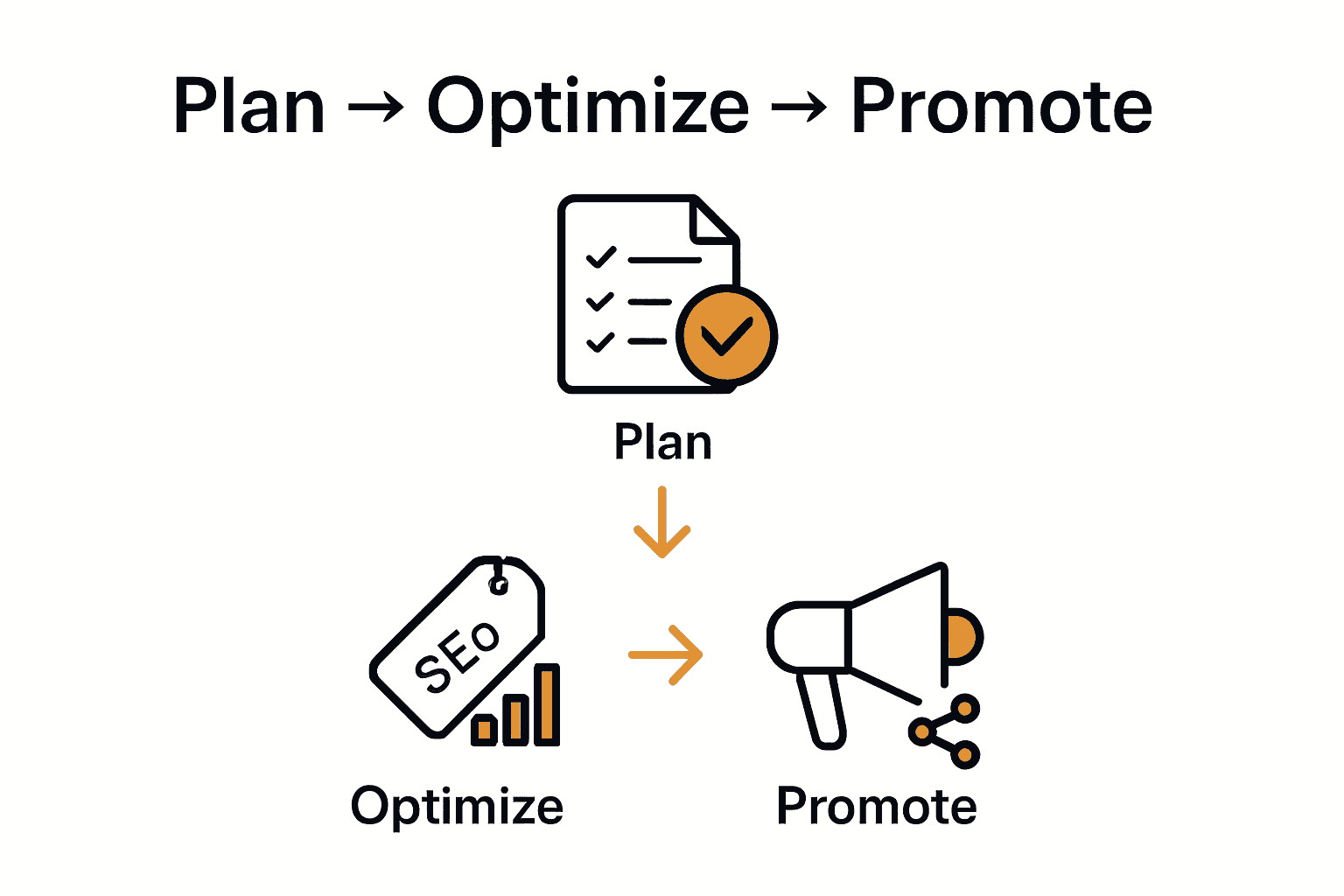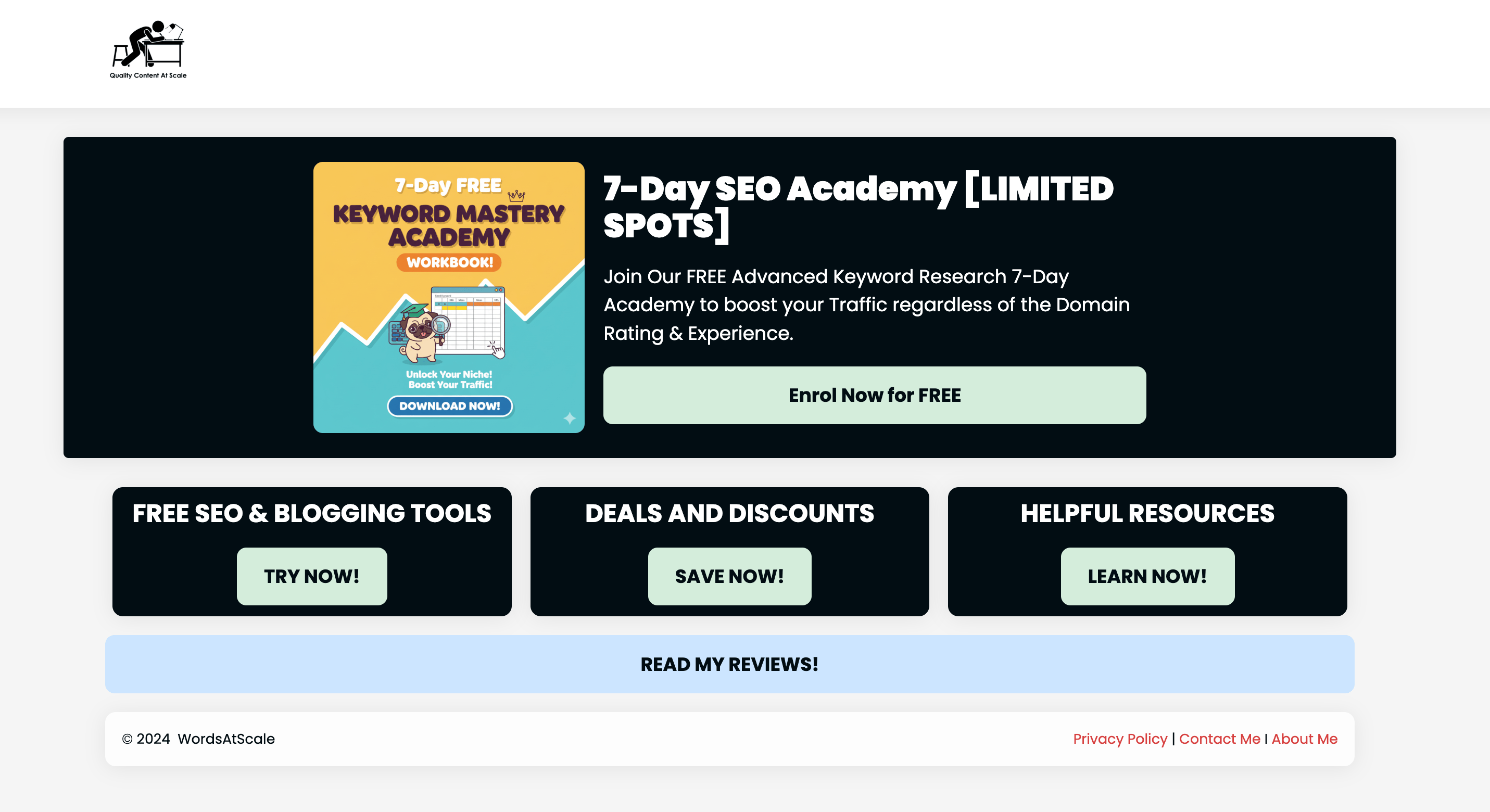Did you know that over 90 percent of online experiences begin with a search engine? Clear goals and a deep understanding of your audience set the foundation for content that stands out in this crowded space. By following a proven approach to planning, optimizing, and promoting your work, you can create valuable pieces that consistently attract visitors and drive growth.
Table of Contents
- Step 1: Define Content Goals And Target Audience
- Step 2: Research Keywords And Search Intent
- Step 3: Structure Topics And Outline Content
- Step 4: Optimize On-Page Seo Elements
- Step 5: Publish Content And Promote Outreach
- Step 6: Measure Performance And Refine Strategy
Quick Summary
| Key Point | Explanation |
|---|---|
| 1. Define content goals and target audience | Establish clear objectives and understand your audience for effective content creation. |
| 2. Conduct thorough keyword research | Identify relevant keywords and understand search intent to connect with your audience. |
| 3. Create a structured content outline | Organize content into sections and subsections for better flow and user experience. |
| 4. Optimize on-page SEO elements | Incorporate keywords into titles, headings, and descriptions to enhance search visibility. |
| 5. Measure performance and refine strategy | Analyze metrics to understand content effectiveness and make data-driven improvements. |
Step 1: Define content goals and target audience
In this crucial first step, you’ll establish the strategic foundation for your SEO content by clearly defining your goals and understanding who you’re writing for. According to HHS Research Guidelines, establishing clear content objectives and understanding your target audience are fundamental to creating effective web content.
To begin mapping out your content strategy, start by asking yourself some key questions. What specific outcomes do you want to achieve with this piece of content? Are you aiming to educate, drive sales, generate leads, or build brand awareness? Next, create a detailed profile of your ideal reader. Research from Marketing Toolbox highlights the importance of understanding your audience’s demographics, interests, and information needs.
A pro tip for defining your target audience is to develop a comprehensive audience persona. This means going beyond basic demographics and diving deep into your audience’s challenges, aspirations, and online behaviors. Sketch out a detailed profile that includes age, professional background, pain points, and preferred content consumption methods. By creating this detailed persona, you’ll be able to craft content that speaks directly to your audience’s needs and interests, dramatically increasing the likelihood of engagement and conversion.
With your goals and audience clearly defined, you’re now ready to move on to the next step of researching and selecting the right keywords that will help you connect with your target readers.
Step 2: Research keywords and search intent
In this crucial step, you’ll uncover the strategic keywords that will help your content connect with your target audience and rank higher in search results. According to CALS Research, conducting keyword research involves identifying terms and phrases potential users are searching for while considering critical factors like search volume, difficulty, and search intent.
Start by brainstorming a list of potential keywords related to your content topic. Use tools like Google Keyword Planner, SEMrush, or Ahrefs to explore search volumes and competition levels. As Marketing Toolbox emphasizes, effective keyword research means selecting terms that best represent your content and reach the most relevant audience. Pay special attention to understanding different types of search intent: informational (seeking knowledge), navigational (looking for a specific website), commercial (comparing products), and transactional (ready to purchase).
A pro tip for keyword research is to focus on long-tail keywords specific phrases with lower competition that precisely match user intentions. These keywords often have higher conversion potential because they reflect more specific user needs. For instance, instead of targeting a broad term like “SEO tips,” you might choose “SEO tips for small business bloggers” to attract a more targeted audience.
 By carefully analyzing search intent and selecting strategic keywords, you’ll create content that not only ranks well but genuinely serves your readers’ needs.
By carefully analyzing search intent and selecting strategic keywords, you’ll create content that not only ranks well but genuinely serves your readers’ needs.
With your keyword research complete, you’re now ready to move on to the next phase of content creation planning your content structure and outline.
Step 3: Structure topics and outline content
In this step, you’ll transform your keyword research into a comprehensive and logical content blueprint that guides your writing process. According to HHS Research Guidelines, organizing content with a clear structure significantly enhances user experience and comprehension by creating a logical flow of topics and making the content easy to navigate.
Start by creating a hierarchical outline that breaks down your main topic into key sections and subsections. As CALS Research emphasizes, structuring topics involves organizing information hierarchically and ensuring each section addresses specific aspects of the overall topic. Begin with your primary headline, then develop 3-5 main sections that cover different angles of your chosen keyword. Under each main section, add 2-3 subsections that provide detailed insights, examples, or explanations.
A pro tip for creating an effective outline is to think like your reader. What questions would they want answered? What information would be most valuable to them? Consider using the inverted pyramid approach where you start with the most critical information and gradually dive into more specific details. This method helps maintain reader engagement and ensures your content remains focused and valuable. By carefully structuring your topics and creating a detailed outline, you’ll create a roadmap that not only helps you write more efficiently but also ensures your content delivers maximum value to your audience.
With your content outline complete, you’re now ready to move into the actual writing phase where you’ll bring your structured plan to life.
Step 4: Optimize on-page SEO elements
In this critical step, you’ll transform your content into a search engine friendly masterpiece by strategically optimizing key on-page elements. According to Marketing Toolbox, optimizing on-page SEO involves incorporating selected keywords into various parts of the webpage, such as titles, headings, meta descriptions, and body content to improve search engine visibility and relevance.
Start by focusing on your primary HTML elements. Craft a compelling title tag that includes your main keyword within the first 60 characters, ensuring it accurately represents your content. For your meta description, write a concise 155-character summary that entices readers and naturally includes your target keyword. As CALS Research emphasizes, the key is integrating keywords naturally while maintaining content readability. Structure your content using header tags progressively: H1 for your main title, H2 for primary sections, and H3 for subsections, strategically incorporating relevant keywords without forcing them.
A pro tip for on-page optimization is to think beyond keyword placement and focus on comprehensive content quality. Ensure your keywords appear naturally throughout the text, aiming for a keyword density of around 1-2%. Include internal links to related content on your website, use descriptive alt text for images, and create URL slugs that are short, readable, and keyword rich. By carefully balancing technical optimization with genuine, valuable content, you’ll create pages that both search engines and human readers will appreciate.
With your on-page elements optimized, you’re now prepared to move forward and ensure your content delivers real value to your audience.
Step 5: Publish content and promote outreach
In this pivotal stage, you’ll launch your meticulously crafted content into the digital world and strategically amplify its reach. According to HHS Research, publishing content is just the beginning the real magic happens through targeted promotion across various channels such as social media, email newsletters, and strategic collaborations to increase engagement and drive traffic.
Start by scheduling your content publication at optimal times when your target audience is most active. As Marketing Toolbox emphasizes, utilizing appropriate promotional channels is crucial for ensuring your content reaches the intended audience. Develop a multichannel promotion strategy that includes sharing on relevant social media platforms, sending targeted email newsletters to your subscriber list, and reaching out to industry influencers or blogs who might be interested in your content.
A pro tip for effective content outreach is to personalize your promotional approach. Instead of generic mass sharing, craft unique pitches for each platform or potential partner. For social media, create platform specific snippets that highlight the most compelling aspects of your content. When emailing potential collaborators, demonstrate the specific value your content provides to their audience. By thoughtfully promoting your content and building genuine connections, you transform a simple publication into a powerful opportunity for engagement and organic growth.

With your content published and promotion strategy in motion, you’re now ready to track and analyze its performance to continually refine your approach.
Step 6: Measure performance and refine strategy
In this final step, you’ll transform raw data into actionable insights that will continuously improve your content strategy. According to HHS Research, measuring content performance involves analyzing critical metrics such as page views, time on page, and conversion rates to assess effectiveness and understand how your content truly performs.
Begin by setting up comprehensive tracking in tools like Google Analytics, Google Search Console, and other platform specific analytics. As Marketing Toolbox emphasizes, evaluating content performance through analytics helps you understand user behavior and content effectiveness. Focus on key performance indicators like organic traffic, bounce rate, average time on page, social shares, and conversion rates. Look for patterns that reveal which content resonates most with your audience and which areas need improvement.
A pro tip for strategic refinement is to treat analytics as an ongoing conversation with your audience. Don’t just look at numbers treat them as signals about what your readers truly want. If certain content types or topics generate more engagement, create more similar content. If specific keywords are driving traffic, consider developing more in depth content around those themes. By continuously analyzing and adapting your strategy based on real performance data, you’ll create a dynamic content approach that evolves with your audience’s needs and search engine algorithms.
With these performance insights in hand, you’re now equipped to create increasingly effective and targeted SEO content that drives meaningful results.
Master Your SEO Content Creation with Proven Tools and Training
Creating SEO content that ranks well is challenging when you are not sure how to define clear goals, select the right keywords, or optimize your pages effectively. Many content creators struggle with understanding search intent and turning raw data into actionable insights. If you want to stop guessing and start producing targeted content that speaks to your ideal audience’s needs while improving your organic traffic those are the exact challenges that wordsatscale.com is designed to solve.

Join the exclusive free 7-day advanced keyword research academy at wordsatscale.com now to learn hands-on strategies that align perfectly with the steps in the SEO Content Creation Guide for Higher Rankings. Use our free SEO tools and expert resources to refine your content planning, structure, and on-page optimization. Don’t miss out on the chance to elevate your SEO skills immediately and watch your content performance soar. Start your journey today with wordsatscale.com and transform your SEO efforts into real results.
Frequently Asked Questions
How do I define content goals for SEO?
To define content goals for SEO, start by identifying specific outcomes you want to achieve, such as educating your audience, driving sales, or building brand awareness. Use these goals to shape your content topics and structure, ensuring your content serves a clear purpose that resonates with your target readers.
What are the steps to conduct effective keyword research?
The steps for effective keyword research include brainstorming potential keywords related to your topic, analyzing their search volume and competition, and understanding the search intent behind them. Focus on long-tail keywords that match your audience’s specific needs, and refine your list to select those with the highest conversion potential.
How can I create a structured outline for my content?
To create a structured outline, break down your main topic into key sections and subsections, ensuring a logical flow of information. Start with your main headline, then outline 3-5 essential sections, each with 2-3 subsections that address reader questions and provide valuable insights.
What on-page SEO elements should I optimize for better rankings?
Optimize key on-page SEO elements such as your title, meta description, headings, and body content by integrating target keywords naturally. Ensure your title is captivating and includes your keyword, and structure your content with proper header tags to enhance readability and search engine visibility.
How do I effectively promote my content after publishing?
Effective content promotion involves sharing your content on relevant social media platforms, using targeted email newsletters, and reaching out to potential industry partners. Personalize each outreach message to highlight the specific benefits your content provides, increasing the chances of wider engagement.
What metrics should I measure to analyze content performance?
Measure key metrics such as organic traffic, bounce rate, and conversion rates to analyze how well your content performs. Set up tracking tools to evaluate these indicators regularly, aiming to identify patterns that inform future content improvements and align with audience interests.
Recommended
- Why Blog for SEO: Complete Guide to Ranking Success – WordsAtScale
- SEO for Beginners: Complete Guide to Ranking Success – WordsAtScale
- SEO Basics for Entrepreneurs: Essential Guide – WordsAtScale
- 7 Key Advantages of Blogging for SEO Success – WordsAtScale
- SEO Content Development: Guide for 2025
- Understanding SEO Best Practices for Your Business – My Blog



